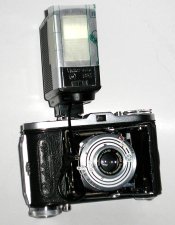- Joined
- Feb 3, 2005
- Messages
- 32
- Format
- 35mm
Hi
I own an Olympus ps200 that I want to use on a Mamiya 7 II purely for fill in flash. It has a GN of 14 at 80-100asa and GN of 7 at 25-32asa.
Is it correct to assume it's GN for 400asa will be around 28 or is it not quite as simple as that.
The flash unit is rated on up to 100asa, so I don't know what the limitations, or problems I may experience would be. I perhaps may look at the Nikon SB-E as another way around this issue. Does anyone else have a cheap alternative.
Regards
Darryl
I own an Olympus ps200 that I want to use on a Mamiya 7 II purely for fill in flash. It has a GN of 14 at 80-100asa and GN of 7 at 25-32asa.
Is it correct to assume it's GN for 400asa will be around 28 or is it not quite as simple as that.
The flash unit is rated on up to 100asa, so I don't know what the limitations, or problems I may experience would be. I perhaps may look at the Nikon SB-E as another way around this issue. Does anyone else have a cheap alternative.
Regards
Darryl




